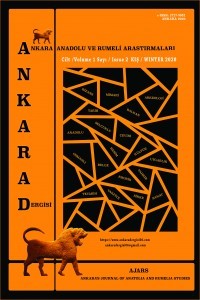DEDE KORKUT’UN ÜÇÜNCÜ NÜSHASINDA GEÇEN OLUMSUZLUK VE YOKLUK BİÇİMLERİ
Olumsuzluk ve yokluk bildiren ifadeler, bütün dillerde mevcuttur. İnsanlar, duygu ve düşüncelerini ifade ederken olumlu ve olumsuz yapıları birlikte kullanmaktadırlar. Bütün dillerde mevcut olan bir kavram olarak olumsuzluk, son yıllarda dilbilim çalışmalarında üzerinde durulan konuların başında gelmektedir. Olumsuzluk ve yokluk biçimlerinin Türk Dilinin her döneminde kullanıldığı bilinmektedir. Olumlu olan her şeyin zıttı ile birlikte var olduğu genel kabul gören görüşlerdendir. Yani, her düşüncenin, hareketin, cümlenin tezadı olduğu belirtilir. Bütün olumlu cümleler, karşıt bir tersinlemeye sahip olduğu gibi her tersinlenen cümle de karşıt bir cümleye sahiptir. Bu çalışmada, Dede Korkut'un yeni nüshasında Tespit edilen olumsuzluk ve yokluk şekilleri cümle içindeki görev ve türlerine göre sınıflandırılmıştır. Yeni nüshada geçen olumsuzluk ve yokluk işaretleyicileri verilirken Dede Korkut'un diğer nüshalarında yer alan olumsuzluk ve yokluk işaretleyicileriyle karşılaştırma yapılmıştır. Benzerlikler ve farklılıklar metinlerde geçen örnek cümlelerle verilmiştir. Sözün özü Türkçenin güzelliklerini yansıtan Dede Korkut'un yeni nüshasında olumsuzluk ve yokluk biçimlerini ortaya koymaya çalışarak bir nebze olsa bile bu dönemde kullanılan dilin işleyişi ve yapısı hakkında bilgi verilmeye çalışılmıştır.
Anahtar Kelimeler:
Dede Korkut;, olumsuzluk;, yokluk;, yeni nüsha;
NEGATIVE AND ABSENCE FORMS USED IN THE THIRD COPY OF DEDE KORKUT
Statements of negativity and absence are available in all languages. People use positive and negative structures together when expressing their feelings and thoughts. Negativity, as a concept that is present in all languages, is one of the most emphasized topics in linguistics studies in recent years. It is known that the forms of negativity and absence are used in all periods of the Turkish language. It is generally accepted that everything positive exists together with its opposite. That is, it is stated that every thought, action, sentence is a contrast. Just as all positive sentences have an opposite inversion, every inverted sentence has an opposite sentence. In this study, the forms of negativity and absence detected in the new version of Dede Korkut are classified according to their duties and types in the sentence. While the negativity and absence markers in the new copy were given, a comparison was made with the negativity and absence markers in the other copies of Dede Korkut. Similarities and differences are given with sample sentences in the texts. The essence of the word is that in the new version of Dede Korkut, which reflects the beauties of Turkish, it was tried to reveal the forms of negativity and absence, even if only a little, the functioning and structure of the language used in this period.
Keywords:
DEDE KORKUT, NEGATIVENESS, ABSENCE, NEW TEXT,
___
- AĞCA, Feruh, Budist Türk Çevresi Metinlerinde Olumsuzluk ve Yokluk Şekilleri, TKAEY, Ankara, 2010
- AKALIN, Mehmet, Eski Türkçesin Grameri, TDK Yay. , Ankara, 2007
- AKAR, Ali, Türk Dili Tarihi, Ötüken Yay.,İstanbul, 2010
- BANGUOĞLU, Tahsin, Türkçe’nin Grameri, TDK Yay. , Ankara, 1990
- ISSN: 2717-9052
- Yayın Aralığı: Yılda 2 Sayı
- Başlangıç: 2020
- Yayıncı: Ankara Üniversitesi
Sayıdaki Diğer Makaleler
MUHASEBE DEFTERLERİNE GÖRE İSTANBUL'DAKİ II. BÂYEZİD KÜLLİYESİNİN MADDİ DESTEK SAĞLADIĞI KURUMLAR
SAVAŞTA VE BARIŞTA BİR YUNAN GEMİSİ: AVEROF YUNAN KAYNAKLARI ÜZERİNDEN BİR ANALİZ
1844-1944 YILLARI ARASINDA BULGARİSTAN’DA YAYINLANAN TÜRKÇE GAZETELER
Ökkeş NARİNÇ, Çevirmen: Ökkeş NARİNÇ
SAFEVÎ KUŞATMA SAVAŞLARINDA KULLANILAN SAHRA TAHKİMATLARI
Serpil AYGÜN CENGİZ, Gamze Merve ERARSLAN
BİR VAROLUŞ BİÇİMİ OLARAK DOĞA: İNGİLİZ ROMANTİK ŞİİRİNDE İKİLİK, KAÇIŞ, PANTEİZM VE EŞ-YAZARLIK
ALMAN ASKERİ VE ALMANYA’DA HAYAT-I ASKERİYE
DEDE KORKUT’UN ÜÇÜNCÜ NÜSHASINDA GEÇEN OLUMSUZLUK VE YOKLUK BİÇİMLERİ
